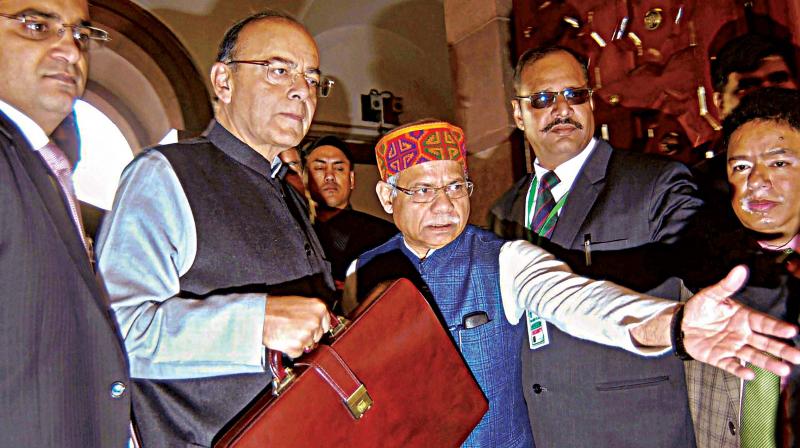A tame exercise: Has govt run out of steam?
The thrust of finance minister Arun Jaitley's fifth Budget was on agriculture and the rural economy.

The thrust of finance minister Arun Jaitley’s fifth Budget was on agriculture and the rural economy. It is tempting to see this as a populist gesture for a government that will go into an election next year. The truth is that Prime Minister Narendra Modi’s government, which had indulged in policy fireworks in the first two years, seems to have run out of steam. The Make in India, Start-Up India, Digital India and Skill India programmes seem to have fallen by the wayside. This is reflected in the subdued suggestion in the Budget speech about formulating an indigenous defence production policy, and this at the end of four years in office and for a party that prides itself on a hawkish stance in matters of security. There is silence on modernising the armed forces and procuring arms to meet the new challenges. There was no reference to manufacturing in the Budget speech, and a passing reference to the services sector being the mainstay of economic growth.
The focus was on agriculture, on on-farm, off-farm jobs, on assured prices for farmers by pegging the minimum support price (MSP) at one-and-a-half times the production cost and providing Rs 2,000 crores for a rural market fund, Rs 500 crores for Operation Green to protect onions, potatoes and tomatoes by creating warehousing facilities, and nearly doubling the allocation for food processing sector from Rs 750 crores to Rs 1,400 crores. Mr Jaitley has also talked of easing restrictions on agricultural exports, saying that the potential for agricultural exports is $100 billion, and that at the moment it stands at a mere $30 billion. There is a newfound realisation that India is an agricultural country and that there is need to leverage its traditional strength, and that India becoming a manufacturing hub should be deferred for another day.
In the first year of this government there was much bravado on the part of the BJP and its leaders of moving people away from agriculture. Most BJP members of Parliament in 2014-15 had argued about the need to shift people out of agriculture. One of the reasons the Modi government wanted to amend the land acquisition bill was to make it easier for others to acquire land for non-agricultural purposes as farmers were not interested in being farmers. That initial enthusiasm of moving away from agriculture seems to have abated in the ruling party.
When Prime Minister Narendra Modi talked about doubling farmers’ incomes by 2022 he was in a generous mood and his focus was on the manufacturing sector, and rightly so. But manufacturing has failed to take off, and as observed in the Economic Survey 2017-18, it’s not able to cope with global competitiveness, apart from issues of the appreciation of the exchange rate, which affects exports. The raising of customs duties on iPhone parts and television parts is a weak gesture to protect and encourage domestic manufacturers, and give fillip to Make in India.
The Budget contains no overall strategy of growth. The belief is that the structural reforms and the push to infrastructure in the past three years should sustain the seven per cent growth momentum, and take it safely into the modest eight per cent growth trajectory. There is absence of ambition in pushing growth rates into double digits. It is of course realistic to be modest and avoid setting up unreachable targets. There is also some realisation in the government that India cannot plough its own furrow of growth, and that it can only grow when the global economy revives.
The incentives announced in the social sector like medical insurance of Rs 5 lakhs per annum to each of 10 crore poor families is the standard welfare measure which is the attitude of a nanny state, which wants to give out of the state’s bounty because the number of tax payers has increased thanks to demonetisation and the implementation of Goods and Services Tax (GST), and tax revenues have grown too. Finance minister Arun Jaitley’s sole satisfaction lies in the increased tax revenue bounty of the government. He said that the people celebrated demonetisation as “imaandaari ka utsav” (feast of honesty). There is not much talk about how the increased revenues would be spent on boosting economic growth.
In 2014 Prime Minister Modi exuded confidence about transforming the country and its economy. The irrational exuberance of the government on its ability to change and guide the economy has died down. Even the zeal for reforms is not what it was earlier. This could be seen in Mr Jaitley pegging the disinvestment target for 2018-19 at Rs 80,000 crores though he declared that last year’s disinvestment target of Rs 72,000 crores was exceeded and the actual collection was Rs 100,000 crores. It’s not the fault of the Modi establishment that it has not been able to break the barriers to growth. It underestimated the complexities involved in an economy of a giant of a country like India. These leaders believed that the Indian economy could be moulded from above as in Singapore and South Korea.
While explaining Economic Survey 2017-18, chief economic adviser Arvind Subramanian had said there is no need for radical policy measures and all that the government has to do was to consolidate structural reforms like GST and the bankruptcy code. Mr Jaitley just did. “This year’s Budget will consolidate reforms,” he said. The reforms were administrative like GST and the Insolvency and Bankruptcy Code (IBC). Demonetisation was not a reform by any stretch of the imagination. It is the illusion of the Modi government that a less-cash economy boosts economic growth. It may help in tax collections, but not in economic growth.

